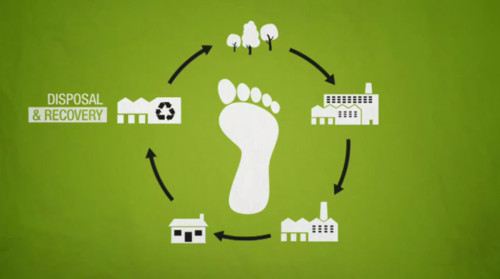Each step in the life cycle of a product has an impact on the environment, also called ecological footprint – from the sourcing of the material needed to produce it to its disposal. When it comes to paper and print products the ecological footprint is often measured in terms of the CO2 emission.
Carbon dioxide, CO2, is a naturally occurring and important greenhouse gas, warming the Earth’s surface to a higher temperature – this has always been the case. However, as we all know, the burning of carbon-based fuels has rapidly increased the CO2 concentrations in our atmosphere and increased the rate of global warming and climate change. The average CO2 emission in Austria is 10 tons per inhabitant, in the US even 20 tons. Another interesting fact about CO2 is that it lasts for more than 100 years in the atmosphere.
For paper, as for all other products, the first step is to avoid and reduce carbon emissions. This can be done along the whole life cycle of paper products as you can see in the video created by paper manufacturer Mondi.
http://www.youtube.com/watch?feature=player_embedded&v=5065Zp4sNAE
When it comes to the sourcing of paper, the WWF recommends sourcing virgin fiber from credibly certified (FSC or PEFC for instance) natural forests and plantations and maximizing the use of recycled fibers in order to reduce a paper’s ecological footprint.
During the production of paper, the use of so-called clean technology can minimize paper products’ impacts on climate change and water. Carbon dioxide emissions, as well as the amount of waste water from the manufacturing process, can be reduced by investing in new plants, retrofitting existing plants, heat recovery and increased paper recycling. It is not only important to reduce the fuel consumption but also to use renewable energy sources.
Of course, also sustainable consumption practices are key to the reduction of the environmental impact of paper. This means that we should consume paper in a responsible way by for instance developing clever and material-saving packaging solutions. And of course, recycling is one of the easiest ways to reduce your ecological footprint.
While avoiding CO2 entirely is a desirable, long-term goal, it is not possible to manufacture paper entirely without producing any CO2, yet. This is why paper manufacturers, as well as other companies and private persons, use the possibility to offset emissions by supporting climate protection projects. According to Climate Partner, there are over 6.000 projects on the carbon market where you can invest to offset your carbon footprint. Such a project can, for instance, mean planting trees since they absorb CO2 and provide other benefits for the environment. By offsetting their emissions manufacturers, such as Mondi, are able to offer a paper which is CO2 neutral.
If you want to learn more about the environmental aspects of paper and help Mondi plant new trees, take part in the Mondi Green Range Quiz and become a Green Ranger. Good luck!

